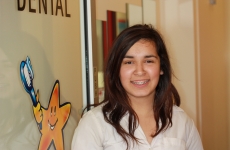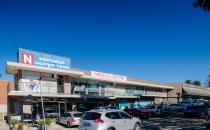You are here
Braces

Most people will automatically think of the "train-track" braces when Orthodontics is mentioned.
However, there is much more than that.
Orthodontics is the branch of dentistry that deals with alignment problems of the teeth and jaws. However orthodontics literally means "straight teeth", and therefore, perhaps Orthopaedic Orthodontic is a more appropriate term.
Orthopaedic Orthodontic is our current approach towards achieving a better face, a better smile, and hopefully, a more stable long term result. The aim is to correct the misalignment of the upper and lower jaws as soon as appropriate (because ideally one would like to utilise the natural growth spurt to achieve the desired result), to correct any inappropriate musculature habits that can contribute significantly to the relapse of treatment, and of course, to straighten the teeth.
For convenience sake, we will be using Orthodontic and Orthopaedic Orthodontic as equivalent in the following discussion, as well as the rest of this website.
Jaw development and musculature habits are by far the more difficult components to modify. See The growing face of a child and Breathing/Airway for more information. However, with clinical experience and technology advancement, it is gradually becoming easier. Whereas teeth straightening is, by comparison, a little easier.
So why should one bother with orthopaedic orthodontic treatment?
Some benefits of orthodontic treatment include
- Improved appearance, therefore enhancing self confidence.
- Easier oral hygiene maintenance, therefore reducing chances of gum disease and decay.
- Better occlusion (or "bite"), therefore improved chewing ability, indirectly assisting in better digestion.
- Better speech for some people -- when the upper arch is way too narrow and the tongue simply cannot fit in easily to generate the sounds required, one will unavoidably "talks funny".
- Reducing gum problems, such as premature gum recession around a tooth due to its undesireable angulation.
- Reducing tooth wear -- when teeth are malaligned, some can get seriously damaged and worn down just with normal function (even if there is no significant parafunction or bruxing habits).
So when should a child have an orthodontic assessment?
Ideally, a child should have an initial orthodontic assessment at the age of around 7 years old. An OPG xray will be a great tool in assisting the dentist/orthodontist in providing a more accurate assessment, particular in terms of looking at those permanent canine teeth that are yet to erupt.
However, some kids show signs of skeletal bone discrepancy at an even earlier age. An experienced dentist/orthodontist can often pick these up and early intervention may be warrented to minimise future treatment, or to reduce the complexity of future treatment. This is where Myofunctional Trainers can become a rather valuable tool, if used appropriately.
When should orthodontic treatment commence?
Early treatment is sometimes recommended to minimise future treatment or reduce the complexity of future treatment. This is often the case when the upper jaw is underdeveloped.
If early treatment is not indicated, then the best time to start will usually be the stage where the permanent 2nd molars are just about to erupt, ie around 12 years old.
As for adults who did not have the opportunity to access orthodontic treatment when they were young, there is still hope.
Adult orthodontics used to be an extremely difficult process, with very long treatment time (easily 3-5 years), lots of discomfort and higher rate of complications. However, with improvement in technology, and advancement in the understanding of the science and biology of tooth movement, this is no longer the case. Adult orthodontics can be quite successful although adults will need slightly longer treatment time due to increased bone density, as well as the difference in rate of bone growth. Where there is significant bony discrepancy, surgical assistance may be required to achieve the desired result.
Will extraction or removal of teeth be required?
Our practice do not believe in routine tooth removal for orthodontic purposes. We usually try to develop the jaw to its genetic potential and avoid extracting teeth. However, in a very small number of cases, it may be necessary to remove teeth to achieve the desired result. Should this be the case, we will always discuss in details with you.
What sort of "braces" are available?
Appliances used will usually depend on the merit of individual case, as well as the clinician's preference and experience.
There are generally categorised as follow:
- Expanders -- can be fixed or as a removeable plate
- Facemask
- Headgear
- Sequential clear aligners -- eg. Invisalign
- Removeable orthodontic plate
- Fixed appliances -- ie braces (train-track type). For the conventional type that goes on the front surfaces of the teeth, they come in metal, ceramic or plastic. For the type that goes on the inside surfaces of the teeth (Lingual orthodontics), they come only in metal.
Are there any complications to orthodontic treatment?
Just as any medical procedures, there is always some risk of possible complications despite our best effort to minimise them. While some complications are of temporary nature, others can have permanent effects. Most people will have no or minimal complications, but if there is any that you have concerns about, be sure to talk to the dentist about it as early as possible.
Potential complications that may happen include, but not limited to,
- damage to tooth enamel -- range from decalcification of the enamel to decay of the tooth, commonly associated with insufficient oral hygiene during orthodontic treatment and inappropriate dietary habits, esp excessive sugary food/drinks.
- inflammation of the gum -- often related to insufficient oral hygiene as well. However there is a small number of patients who simply react more sensitively to the presence of braces. These patients may require addition check ups and cleaning procedures.
- damage to roots of teeth -- while it is common and widely accepted that the root will shorten a little while being moved, excessive shortening of the roots can affect the long term retention of tooth and increase the chance of root canal treatment. A tooth which has been moved with excessive force, experienced previous trauma, or has existing large cavity/filling is more likely to suffer from root shortening.
- damage to pulpal tissue of a tooth (ie nerve) -- while a tooth is being moved, there are compression and distraction stress on the pulpal tissue and blood vessels supplying the tooth. Some discomfort or pain may be felt but usually resolve fully. Occasionally and rarely, the pulpal tissues may die, therefore requiring root canal treatment.
- damage to the oral soft tissues -- particularly at the very early stages of appliance use or braces being put on. It can range from a red sore spot to ulcer formation. They will usually disappear relatively soon with salt water rinse and the soft tissue often "toughens up" with time.
- loose appliances -- while intraoral removeable appliances are usually too big, smaller fixed pieces may become dislodged, and accidentally swallowed or aspirated into the lungs (more likely the former, if any). Urgent medical attention will be required if it is the latter, however this is rather rare. Facemask and headgears can cause injury to the face or eyes, esp during rough play, but the modern designs have aimed to minimise this complication as much as possible.
- allergic reactions -- rare, but could be towards the metal Nickel used in some bands or brackets, latex in intra-oral elastic bands or other devices, or composite and acrylic adhesives.
- prolonged treatment time -- could be due to poor cooperation and compliance from the patient with treatment regimen, unfavourable jaw development, or unpredictable growth of the jaws.
- failure of treatment -- often associated with premature termination of treatment due to oral hygiene or patient compliance issues.
- relapse -- ie. some teeth move away from their corrected positions after orthodontic treatment is completed. The front teeth are most prone to this and the issue can usually be well controlled by wearing the retainers religiously as instructed. Having said that, teeth are part of our living body and do move gradually with age, just like any other parts of our body. Some of these tooth movements, esp years after the initial orthodontic treatment was completed, may have nothing to do with the orthodontic treatment at all.
- jaw joint problems -- there has been suggestion that orthodontic treatment can cause jaw joint problems but there is yet to be solid proof of this. Temporomandibular joint disorders can be multifactorial and certain orthodontic treatment may be one of the contributing factors.
Our Doctors
Opening hours
- Monday: 9am–5pm
- Tuesday: 9:30am–6pm
- Wednesday: 9am–5pm
- Thursday: 9am–5pm
- Friday: 9am–5.30pm
- Saturday: 9am–1pm
- Sunday: Closed

